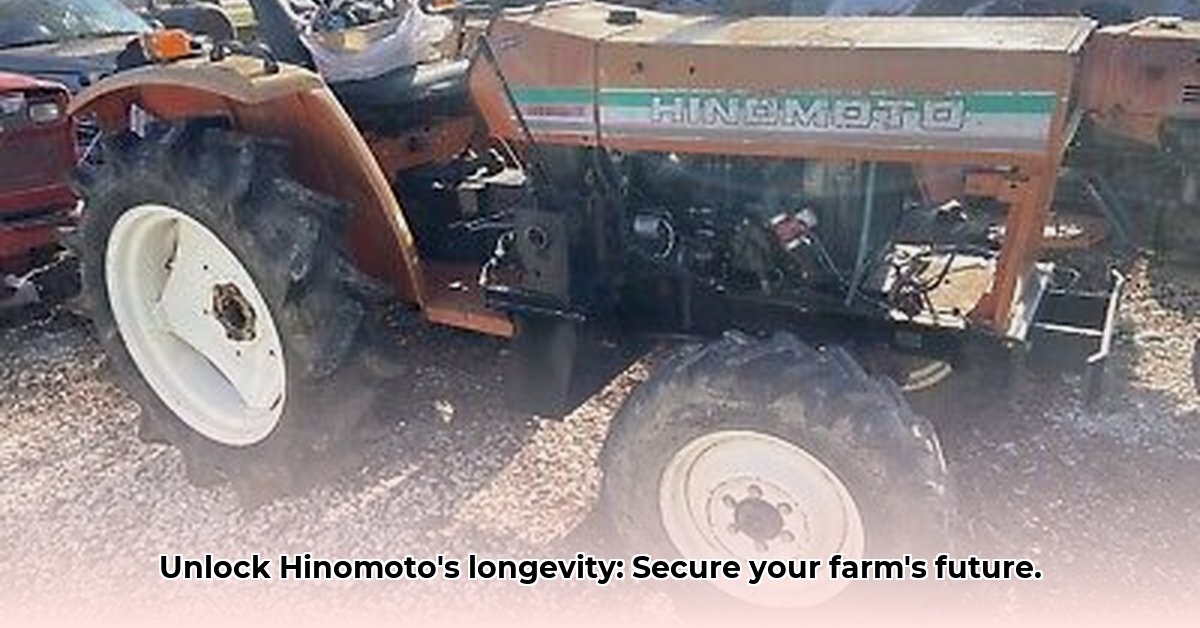
Finding parts for your Hinomoto tractor can be challenging, especially given the discontinuation of their production. This guide provides practical solutions for sourcing parts, performing preventative maintenance, and troubleshooting common issues, empowering you to keep your Hinomoto running efficiently and sustainably for years to come. It's a comprehensive resource designed to extend the lifespan of your dependable Hinomoto and support your farming operation. For additional resources, check out this helpful Hinomoto parts guide.
Hinomoto Tractor Parts: Securing Your Farm's Future
The discontinuation of Hinomoto tractor production presents a significant challenge for farmers who rely on these reliable workhorses. However, with a strategic approach combining parts sourcing, preventative maintenance, and community engagement, the longevity of your Hinomoto can be ensured. This translates directly into the long-term sustainability and success of your farm. Don't let parts scarcity hinder your agricultural operations; this guide provides the knowledge and resources you need to overcome this obstacle.
The Hinomoto Legacy: Durability and Sustainability
Hinomoto tractors built a reputation for robustness and efficiency, particularly well-suited to smaller farms. Their inherent durability is a testament to their design. While the brand may no longer produce new tractors, the investment in maintaining existing Hinomoto tractors represents a commitment to sustainable farming practices by extending the lifespan of valuable equipment and minimizing waste. This is more important than ever in today's environmentally conscious agricultural landscape.
Sourcing Hinomoto Tractor Parts: A Practical Guide
Finding the right parts requires a multi-pronged approach. It's all about resourcefulness and persistence. Here's a step-by-step guide:
Identify the Part: Precisely identify the needed part using your owner's manual (if available), noting part numbers and providing clear photos if necessary. Online forums dedicated to older tractors are invaluable resources for part identification.
Explore Your Options: Multiple avenues exist for sourcing parts:
- Established Dealers: Contact agricultural equipment dealers, especially those experienced with older tractors. They may have parts in stock or know where to find them.
- Online Marketplaces: Utilize online marketplaces like eBay and specialized agricultural equipment websites. Always verify seller reputations and read reviews carefully to avoid counterfeit parts.
- Parts Specialists: Connect with repair shops specializing in older tractors. They often have extensive parts networks and may carry used or refurbished components.
- Online Forums: Engage in online forums and communities dedicated to Hinomoto tractors. This is an excellent way to share information and find parts from fellow owners.
Compare and Verify: Once potential suppliers are identified, compare prices, shipping costs, and delivery times. Remember to factor in potential import duties or taxes. Always confirm part availability before purchasing.
Due Diligence: Before committing to a purchase, thoroughly investigate the supplier's reputation and check online reviews.
Preventative Maintenance: Maximizing Hinomoto Lifespan
Regular, proactive maintenance is crucial for extending your Hinomoto's lifespan and preventing costly repairs. A well-maintained tractor is a productive tractor. The following checklist provides a solid foundation:
- Oil Changes: Use the correct oil grade specified in your manual, adhering to the recommended change intervals.
- Fluid Levels: Regularly check and top off coolant, hydraulic fluid, and transmission fluid. Low levels can lead to serious damage.
- Filter Replacements: Replace air, fuel, and oil filters according to the manufacturer's recommendations. Clean filters improve engine performance.
- Belt Checks: Inspect belts for cracks, fraying, or excessive wear and replace as needed. Worn belts can lead to unexpected failures.
- Tire Pressure: Maintaining correct tire inflation boosts fuel efficiency and reduces wear.
- Regular Inspections: Conduct regular visual inspections to identify leaks, unusual noises, or other potential problems. Early detection is key.
Troubleshooting Common Hinomoto Issues
Even with diligent maintenance, unexpected problems can occur. Familiarize yourself with common issues and potential solutions:
- Starting Problems: This could indicate a weak battery, a faulty starter motor, fuel delivery issues (clogged fuel filter or low fuel), or ignition system problems.
- Hydraulic Problems: Leaks, slow response, or complete failure could result from low hydraulic fluid, damaged seals or hoses, or a malfunctioning hydraulic pump.
- Transmission Issues: Difficulty shifting, grinding noises, or slipping gears might indicate worn components, low transmission fluid, or more extensive internal transmission problems.
Consulting a qualified mechanic is advisable for repairs beyond your expertise.
Building a Sustainable Hinomoto Parts Network: Long-Term Strategies
A proactive approach to parts acquisition is vital for long-term sustainability. This means building relationships and employing strategic practices:
Nurture Relationships: Build strong relationships with reliable parts suppliers. Reliable suppliers become invaluable.
Maintain Detailed Records: Keeping meticulous maintenance logs helps track repairs, identify potential issues, and order replacement parts efficiently.
Explore Reclamation and Rebuilding: Consider using salvaged parts or rebuilding worn components as cost-effective alternatives.
Engage the Community: Participate in online forums and local farming communities to exchange information and resources.
This holistic approach ensures your Hinomoto tractor remains a productive asset on your farm for many years to come.
Environmental Considerations: Sustainable Farming Practices
Responsible maintenance practices directly contribute to sustainable agriculture. Correct fluid disposal, fuel-efficient operation, and responsible part sourcing minimize environmental impact. While specific data may be limited, the overall impact of extending the life of your Hinomoto through responsible maintenance is undeniably positive. It demonstrates a commitment to environmentally conscious farming practices.
Conclusion: Investing in the Future of Your Farm
Securing parts for your Hinomoto tractor may require more effort than for newer models, but the long-term benefits far outweigh the challenges. By combining proactive maintenance, smart parts sourcing, and community engagement, you ensure that your Hinomoto continues to serve as a vital tool for your farm's success and sustainability for years to come. It's an investment in your farm's future – and in environmentally responsible farming.